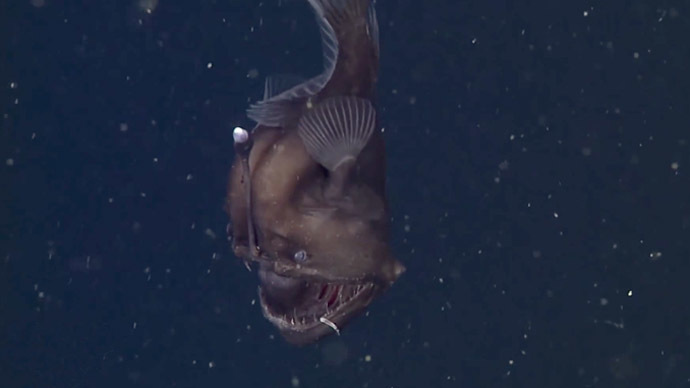Finding Nemo monster is real: Rare black seadevil caught on video

A nightmare-inducing sea creature made famous in ‘Finding Nemo’ was caught on video in the depths of the ocean for the first time. Scientists believe global warming is affecting its environment, bringing the rare anglerfish species to shallower waters.
As shown in Pixar’s famous fish film, anglers get their name from the built-in fishing rod attached to their foreheads. The black seadevil (scientific name Melanocetus) lives in the pitch-black depths of Monterey Canyon off California’s coast, and uses its luminescent orb to attract prey.
“In the darkness of deep water, they flash the light to attract prey and draw them near the angler's mouth. When a fish or a squid swims up, it is quickly inhaled by the angler's huge mouth and trapped by its long, sharp teeth,” senior scientist Bruce Robison said in a video of the seadevil released by the Monterey Bay Aquarium Research Institute (MBARI).
MBARI scientists spotted the secretive species 2,000 feet (600m) below Monterey Bay’s surface, but it also lives in the “freezing, crushing water four times deeper,” the San Jose Mercury News reported.
The footage captured at this depth by MBARI’s remotely operated vehicle, ROV Doc Ricketts, is believed to be the first video ever made of this species alive and at such a depth, the institute said in the video description. Fewer than half a dozen encounters with any type of deep-sea anglerfish have ever been recorded by deep-diving research vehicles, MBARI noted in a statement.
The ROV located the fish during a “midwater transect” last Monday, institute spokeswoman Kim Fulton-Bennett told CNN. "This means we 'fly' the robot through the water at a series of different depths (10 minutes at each depth), and count all the different types of animals we see."
The female seadevil is recognizable from ‘Finding Nemo,’ where it snuck up on fish Dory and Marlin as they search for Nemo. As scary as the anglerfish might be, it is only 9 cm (3.5 in) long. The male is even smaller, “like a tiny little baby,” a video called ‘True Facts about the Angler Fish’ says.
“He attaches himself to the female by biting her, and then digesting part of his face so he fuses with her flesh,” the description continues. “He then atrophies, losing his digestive organs, brain, heart and eyes, and winds up nothing more than a pair of gonads, which release sperm when needed.”
Finding a female ‒ no matter how ugly she may appear‒ is imperative for the male.
"If they don't find a female, they drown," Ted Pietsch, professor at the University of Washington and expert on the deep-sea anglerfish, told the Mercury News. "They're not even properly equipped to eat."
Females also collect males throughout their lifetimes. Robison told KSBW that he has seen up to 11 males attached to a single female.
Not much else is known about the elusive seadevil, however. "A video would tell us a lot about how it moves, swims, orients to gravity," Pietsch noted.
Robison and his international team of researchers didn’t just capture video of the angler; it captured the black seadevil to study. Unfortunately, they do not know how long it will survive.
The team is studying the possible impacts of rising water temperatures on deep-sea animals. Robison told KSBW the fish discovery was thanks to the mid-water rest barometer, the only one of its kind.
"What we're trying to do experimentally with instruments that we take down into the ocean is to learn what the range of capabilities of these animals are," he said. "Now that the temperature is rising, many species may not have the ability to adjust to the rising temperatures."
The temperature increase, he told the Mercury News, is "probably because of global warming. If the temperature continues to rise and the amount of oxygen continues to decrease, things are going to change."
The problem the black seadevil and other deep-sea creatures face from global warming is that oxygen ‒ which is already scarce at those depths ‒ will decrease even more.
"Animals that live in the oxygen minim zones are adapted to low oxygen, but they might be close to their limit," Brad Seibel, an assistant professor of marine biology at the University of Rhode Island, told the Mercury News. That could lead to stunted development, and possibly force the animals to head to shallower waters.
And animals near the surface would have to swim to colder waters. These mass migrations would alter ecosystems as food and predators might not shift in the same way, Seibel said.












